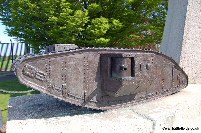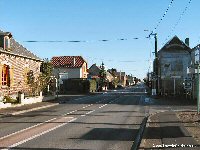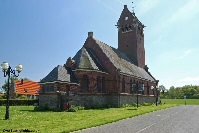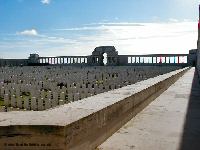Pozieres
The World War One Battlefields site is undergoing a major update, with pages being converted to a new, user-friendly mobile format. The updated pages can be found at Updated World War One Battlefields. Some pages such as this one remain in the original format pending update.

The Australian flag flies at Pozieres
This small village is located on a ridge of high ground between Albert and Bapaume, and thus had great strategic importance to both the Allies, who wanted to take it as part of their advance, and the Germans who clung determinedly onto it.
Although the village and ridge was a 1st July objective for the 8th Division, the village was not taken until the 25th of July, and the crest of the ridge not until the 5th of August. The 1st and 2nd Australian Divisions respectively were the units which finally gained those objectives, whilst the Australian 4th Division later took Mouquet Farm, not far from here. There were over 23,000 casualties in these actions, and the memorials here and the resonance the name of Pozieres still has for Australians are testament to that. On the 5th of August, Douglas Haig recorded in his diary "The Australians gained all their objectives north of Pozieres and beat off 3 counter-attacks. A fine peice of work."
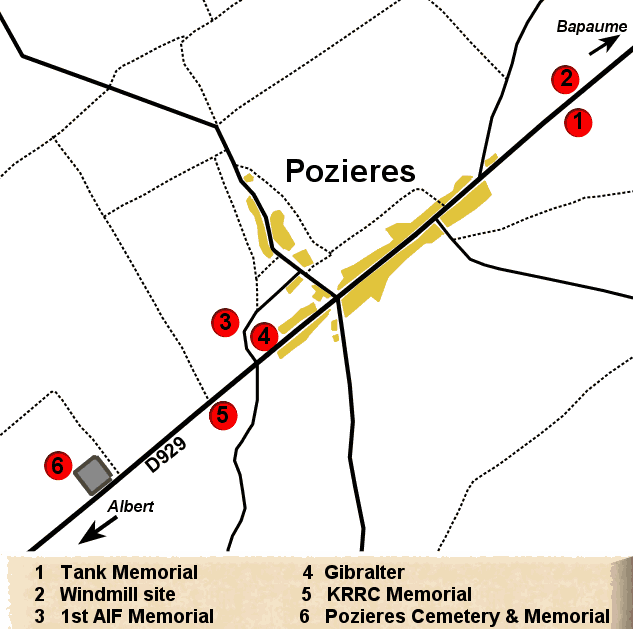
Map of the Pozieres Area
As you enter Pozieres on the main D929 leading from Bapaume in the direction of Albert, there is a high radio mast located on top of the ridge, and this can be seen from many points around, making it a useful marker for determining positions when in other areas. Pozieres provides excellent views of the surrounding battlefields today, and at the 1st Australian Division Memorial (see later) there is an elevated observation platform where you can take good advantage of this.
Just after the radio mast on the left is the Tank Memorial. Three tanks set off from this point on the first day they were ever used as a weapon of war; 15th September 1916. The memorial has an inscription on the front commemorating this.
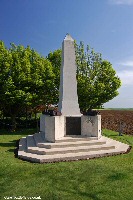
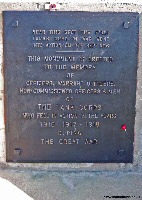
The Tank Memorial and the inscription plaque on it's front
On panels on the other three sides the battles in which tanks were used in 1916, 1917 and 1918 are listed. The increasing number of battels (two in 1916, four in 1917 and seven in 1918) demonstrate the increasing importance of the tank in the Great War.
The picture below shows the memorial as it appeared probably in the 1930s before the trees surrounding it grew as tall as they are today.
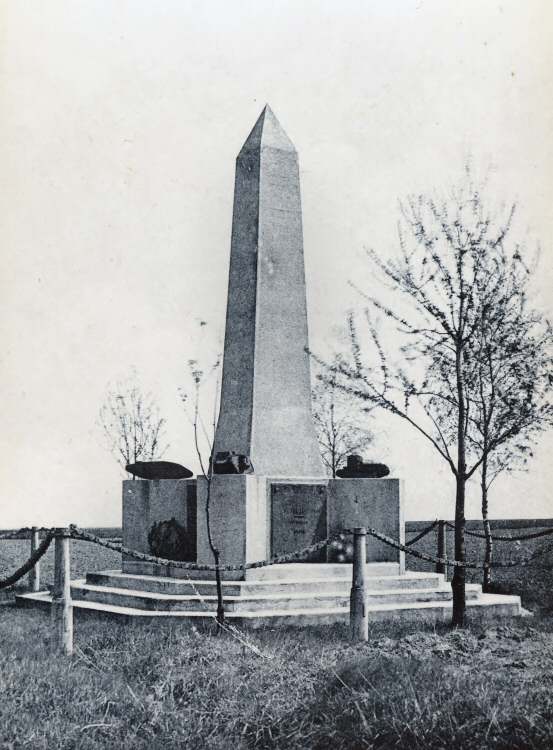
The Tank Memorial in perhaps the 1930s
At each corner of the memorial is a small-scale replica of some of the tanks used. The two at the front look very similar, but are in fact slightly different, being Mark IV and V Heavy tanks respectively.
The two tanks at the back are a Mark I Gun-carrier tank and a Medium A Whippet, and are pictured below.
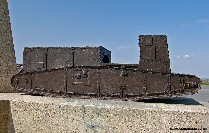
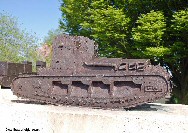
Mark I Gun-carrier tank (left) and Medium A Whippet (right) tanks
Around the memorial on three sides is a chain which looks rather like a very large bicycle chain. According to the Holt's guide this is constructed of early tank driving chains, linked to six-pounder gun barrels.
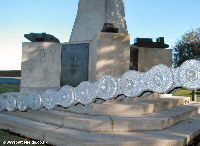
Tank driving chain surrounds the Memorial
From the Tank Memorial are excellent views across the battlefields in all directions except back toward Albert; trees and the village itself block the view in this direction. The elevated viewing platform at the 1st Australian Division memorial on the other side of the village (see below) affords views in this direction.
Directly opposite the Tank Memorial, across the road, is the first of several sites associated with the Australians who fought so hard in this area. This is the site of Pozieres Windmill, which was located on the highest point of Pozieres ridge and in fact the highest point (known as Hill 160) of the Somme battlefield. The site is flanked by the flags of Australia and France, and two large stones with the insignia of the Australian Imperial Force stand by the walkway leading to it.
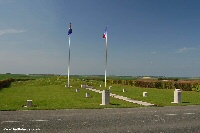
The site of Pozieres Windmill today
A walkway leads up to a memorial stone bench with an inscription that records the capture of this site on August the 4th 1916, and states that the Australian troops "fell more thickly on this ridge than on any other battlefield on the war". Behind this is a Ross Bastiaan bronze plaque, similar to those located at other sites of particular significance to the Australian forces. The plaque, which was unveiled by Lieutenant-General J.C. Grey on the 30th of August 1993 gives information about the battle, stating that the Australians went into battle here on the 23rd of July 1916 and fought until they were relieved on the 5th September by the Canadians. It also has a relief map of the Somme area.
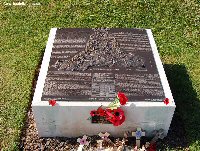
The Ross Bastiaan bronze at the Windmill site
Behind the bench and bronze plaque are the concrete remnants, presumably of the German fortifications on the site of the windmill, can be seen in the uneven ground behind the flags.
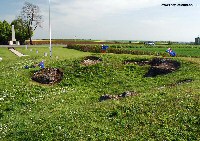
The remains of the Windmill or fortifications built into it today
From the site of the windmill, the Thiepval memorial can be seen to the back left. Just north-west of the windmill site is where Lieutenant Albert Jacka (who had won a Victoria Cross previously in Gallipoli) acted with extreme bravery to thwart a German counter-attack on the Australian lines on 7th August 1916. The Digger History website has some information on Jacka. He was recommended for a bar to his VC for his actions near Pozieres, but was awarded instead the Military Cross, something Australians often feel was unfair. Although Jacka was later also awarded a bar to his MC, Captain Noel Chavasse remains as the only man in the Geat War to have been awarded a bar to a VC.
In Pozieres village, on the left again as you go towards Albert is Le Tommy cafe, with toilets, and hot food and drinks (including traditional English breakfast).
After the war, Pozieres, like the other Somme villages, was rebuilt, and by the late 1930s the War must have seemed a long time ago. This picture shows the main road leading in the direction of Bapaume. The sign to the Thiepval memorial may just be seen by the road leading off to the left. The picture below that was taken from nearly the same spot in 2005. Although there have been some changes, there is remarkably little difference between the two - except that these days standing in the main D929 road to take the photograph is considerably riskier!
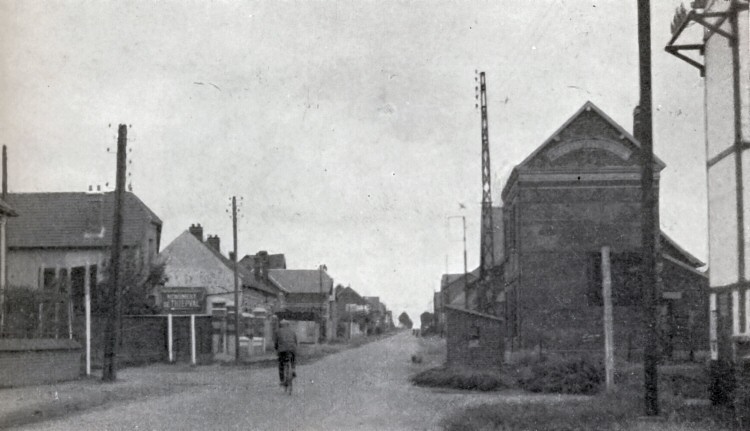
Pozieres in the 1930s. The Thiepval memorial is signposted to the left. Photo A.J. Insall
Taking the turn towards Thiepval leads to the site of Mouquet Farm, where there is another Ross Bastiaan bronze and also good views towards the Thiepval memorial. The bronze tablet was unveiled by Tim Fischer, Deputy Prime Minister of Australia in September 1997. Mouquet Farm is another site with Australian connections (sometimes known as 'Moo-cow' or 'Mucky' Farm). After taking the village, the Australians founght for a month trying to take Mouquet Farm, but were relieved by the Canadians on the 5th of September. The farm was not taken until nearly another month after that.
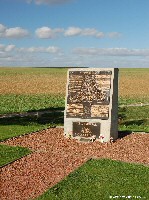
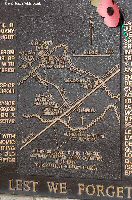
Ross Bastiaan bronze at Mouquet Farm
When I last visited there was a small wooden cross left in memory of a man of the 1st Battalion AIF who was wounded here on the 18th of August 1916, fifty years before I was born. This was Lance-Corporal Walter Eli Tapp, who survived the war and died in 1956. Walter Tapp was born in London, and was a farm-hand in New South Wales when he enlisted in 1915. He was accepted despite admitting on his form that he had previously been rejected on the basis of poor eyesight. His service record suggests he was actually wounded on the 17th of August, the nature of the injury being reported as gun shot wound to the chest. He recuperated in hospital in Leeds, and although he later returned to service with the 61st Battalion he was never fit to return to action and was discharged as medically unfit in February 1918.
Returning to the main road, you pass a large collection of shells in the garden of a house on the left side of the road before it joins the main road.
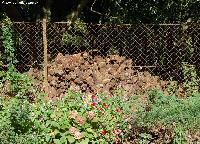
Shells in a garden in Pozieres
Following the main road a short way towards Albert, another road to the right leads to the village church, rebuilt since the war. The village's own war memorial is located in front of this.
Taking a left on the rue d'Eglise to the left of the church, this small road then curves back to the main D929 again (and here the road is named after the 1st Australian Division). Located here are two further sites of interest; the First Australian Division Memorial and 'Gibraltar'.
The First Australian Division memorial used to have field-guns located either side (see the black and white picture below), but these are no longer there.
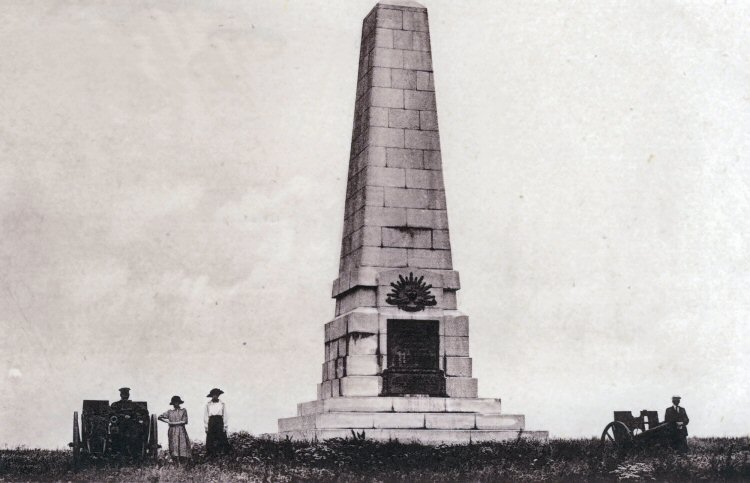
The 1st Australian Division Memorial perhaps in the 1930s. Photo: Combier-Macon
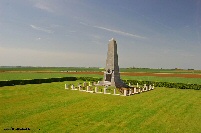
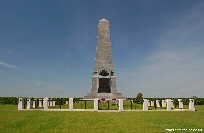
The 1st Australian Division memorial today
In recent years the stone bollards around it and the memorial have been cleaned, and the monument, the inscription and the insignia look better than before. There is a Ross Bastiaan bronze tablet on the site, and across the road is the wooden observation platform mentioned earlier. This gives outstanding views across the battlefield, and there are markers on the railing indicating sites that can be seen at various points such as Thiepval (the memorial can be seen clearly from here). Pozieres British Cemetery not far away down the D929 towards Albert can also be seen, and the golden virgin on the basilica in Albert itself when the weather permits. When the weather is wet however, the planks the observation tower is constructed of can be somewhat slippery and care should be taken.
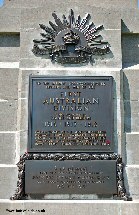
The 1st Australian Division memorial inscription and insignia
Behind the observation platform are the remains of an imposing German concrete shelter known as Gibraltar. The photo below (reproduced courtesy of the Imperial War Museum) shows the structure shortly after it's capture.
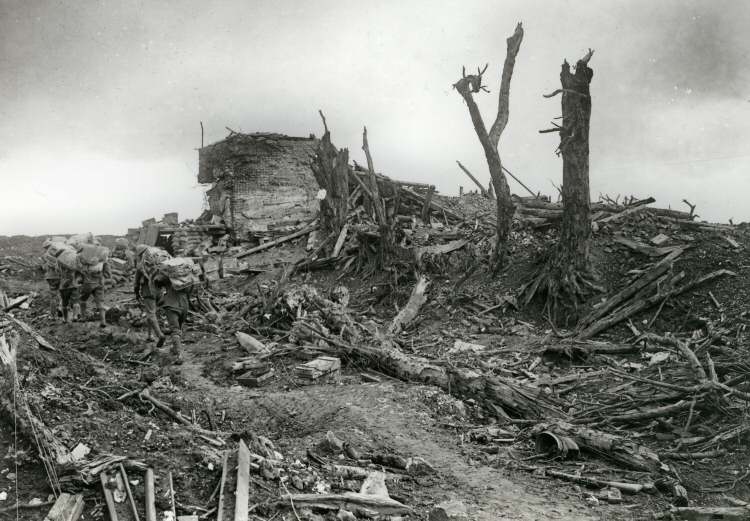
'Gibralter' shortly after it's capture. Q1089: Photograph courtesy of the Imperial War Museum, London
It was destroyed in later fighting, but in the last twenty years the remaining structure below the ground has been partially excavated and can now be seen (although not entered).
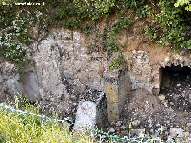
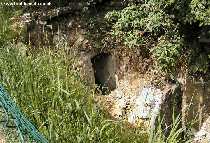
The excavated remains of Gibralter today
In front of 'Gibraltar' is an information board for this site and Pozieres, and to the rear is one covering the Somme region in general. Below is a picture taken just after the war ended of one of the blockhouses that could still then be seen in Pozieres (this is probably not 'Gibralter').
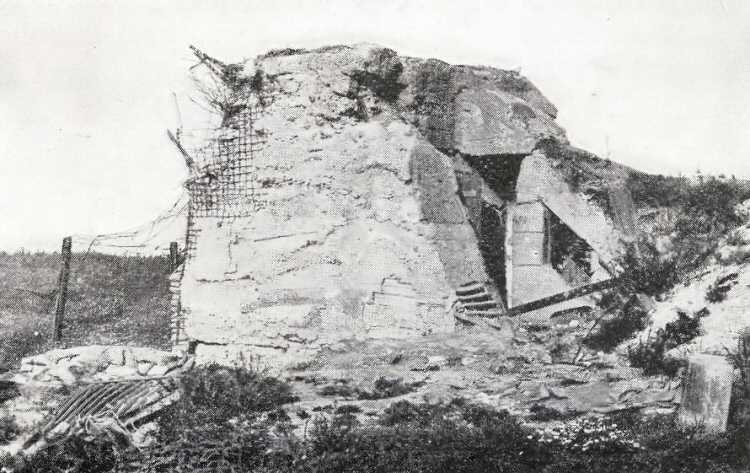
A blockhouse in Pozieres shortly after the War. Photo from The Michelin Guide to the Somme
From this site, which has good parking, if you cross the main road and walk towards Albert, the Kings Royal Rifle Corps memorial can be found towards the end of the village. Tucked a little back from the road, it is easy to miss if you are driving, and as in so many Western Front locations, buildings have encroached around it, and there is now a rather unsightly breeze-block construction outhouse located directly behind it - as compared with a much earlier view as shown below.
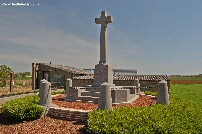
The Kings Royal Rifle Corps memorial
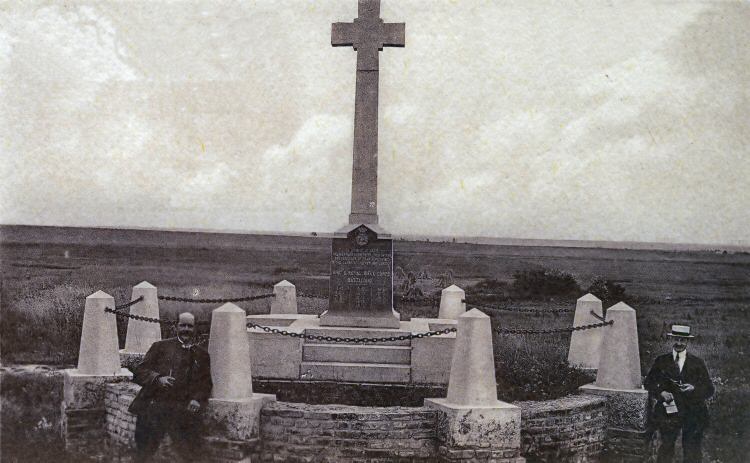
The KRRC Memorial between the wars. Photo: R. Grossel
On the main road from Pozieres towards Albert, the large Pozieres British Cemetery and Memorial is reached on the right side of the road. The inscription above the gate reads "In memory of the Officers and Men of the Fifth and Fourth Armies who fought on the Somme battlefields 21st March to 7th August 1918 and of those of their dead who have no known graves".
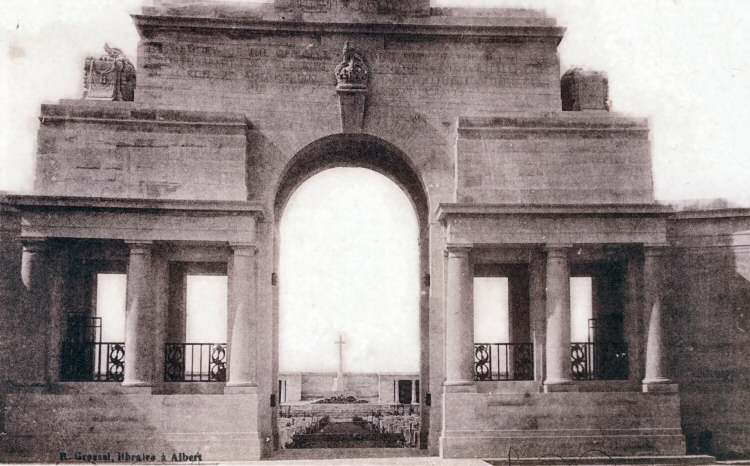
The Entrance to Pozieres British Cemetery & Memorial in the 1930s. Photo: R.Grossel
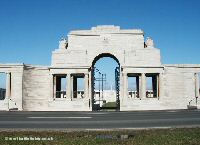
Entrance to Pozieres British Cemetery today
During the German spring advance, Pozieres was lost in 1918, and retaken five months later. The memorial commemorates 14,669 men according to the CWGC website, mainly from the UK but also about 320 South African soldiers. The figures in the register on site are a little lower.
This is one of those sites that brings home the scale of this war. Not far away is the Thiepval memorial; better known and perhaps a more obvious symbol of the losses. But here is a relatively "small" memorial, associated with one fairly small part of the Western Front and one fairly short period of the war. Yes, it was a particularly bloody battle, yet there are nearly 15,000 names here alone and this represents only those who have no known grave.
If you visit here, pause a minute and reflect on this.The cemetery itself is fairly large, with over 2,700 burials, half of which are unidentified. Most of the burials are of soldiers who died during the 1916 battles. Plot 2 to the front right is the original cemetery, which was started in 1916; the other plots were added after the Armistice.
The memorial takes the form of panels along the left, rear and right of the cemetery, with the names of those with no known graves inscribed by regiment.
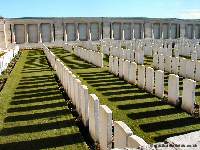
Pozieres British Cemetery looking towards the panels with the names of the missing
Interestingly, the cemetery appears irregular at the front, in that the front wall is not lined up with the first row of graves, and seems to cut in from left to right. This means that the right end of row A plot 2 (the original graves) on the right side is very near the wall, whilst the left end of row A plot 1 on the left of the cemetery is relatively far back. This may be because of a slight change in the course of the road after the war, as the front wall aligns with the road edge. The plan of the cemetery on the CWGC website shows this clearly.
The front left of the cemetery also contains special memorials to 23 men known or believed to be buried here. In Plot 2 grave D2 I noticed a private memorial in the form of a small wooden cross to James Roy, a Lance-corporal in the 16/Highland Light Infantry. There are quite a number of memorials in front of graves in CWGC cemeteries, and often these date from the immediate post-war period, when they were put in place by grieving relatives. This one looked newer and the words on the cross were "James Roy 7th April 1886-1st July 1916 Not forgotten".
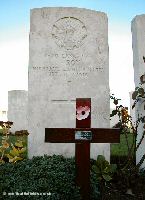
The grave of Lance-Corporal James Roy - just one of many who died on the 1st of July 1916
After placing the picture of this grave on this web-page, I was contacted by Malcolm James Roy, great-nephew of James Roy. It was Malcolm who made and placed the cross in front of his Great-Uncle's grave, in 2005. Malcolm also kindly provided some more information on James Roy. James was born on 7th April, 1886 at Chapelton Cottage, Maybole, Ayrshire in Scotland. He enlisted in late 1914 and was one of the Glasgow Boys Brigade volunteers who formed the 16th Battalion Highland Light Infantry. Following training at Gailes in Ayrshire the battalion moved to England in May 1915 to continue training. James sailed from Folkstone for France on the 23rd of November, 1915.
Between November 1915 and June 1916 James spent many months in the front line trenches, mainly around the area of Albert and Thiepval. He is believed to have spent Christmas Day 1915 and New Years Day 1916 in the trenches at Authuille Wood. At the Battle of the Somme in July 1916 the 16th Battalion H.L.I. formed part of the 32nd Division which was positioned in the British Front Line trenches. The 16th Battalion H.L.I. was part of the spearhead of the attack on 1st July, 1916 near to Mouquet Farm, and was first over the top at 7.30 a.m. It has been estimated that the 16th Battalion H.L.I. lost more than half its original strength of 25 officers and 755 men within 10 minutes of going over the top, and James Roy is believed to have been among these casualties.
Malcolm's brother has the medals awarded to both James and his brother Alexander (Sandy), who also served in the Great War, in the Navy. Sandy fortunately survived.

The medals awarded to Lance-Corporal James Roy. Photo courtesy of Malcom James Roy
Sources
Martin & Mary Middlebrook: Somme Battlefields
Major & Mrs. Holt: Battlefield Guide to the Somme
Paul Reed: Walking the Somme
Malcolm James Roy, for information and pictures relating to James Roy
Gary Sheffield & John Bourne: Douglas Haig War Diaries and Letters 1914-1918
Commonwealth Wargraves Commission website

